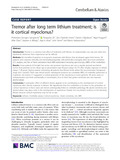JavaScript is disabled for your browser. Some features of this site may not work without it.
| dc.contributor.author | Sarrigiannis, Ptolemaios Georgios | |
| dc.contributor.author | Zis, Panagiotis | |
| dc.contributor.author | Unwin, Zoe Charlotte | |
| dc.contributor.author | Blackburn, Daniel J. | |
| dc.contributor.author | Hoggard, Nigel | |
| dc.contributor.author | Zhao, Yifan | |
| dc.contributor.author | Billings, Stephen A. | |
| dc.contributor.author | Khan, Aijaz A. | |
| dc.contributor.author | Yianni, John | |
| dc.contributor.author | Hadjivassiliou, Marios | |
| dc.date.accessioned | 2020-01-21T15:27:01Z | |
| dc.date.available | 2020-01-21T15:27:01Z | |
| dc.date.issued | 2019-05-22 | |
| dc.identifier.citation | Sarrigiannis PG, Zis P, Unwin ZC, et a., (2019) Tremor after long term lithium treatment; is it cortical myoclonus? Cerebellum & Ataxias, Volume 6, May 2019, Article number 5 | en_UK |
| dc.identifier.issn | 2053-8871 | |
| dc.identifier.uri | https://doi.org/10.1186/s40673-019-0100-y | |
| dc.identifier.uri | https://dspace.lib.cranfield.ac.uk/handle/1826/14981 | |
| dc.description.abstract | Introduction: Tremor is a common side effect of treatment with lithium. Its characteristics can vary and when less rhythmical, distinction from myoclonus can be difficult. Methods: We identified 8 patients on long-term treatment with lithium that developed upper limb tremor. All patients were assessed clinically and electrophysiologically, with jerk-locked averaging (JLA) and cross-correlation (CC) analysis, and five of them underwent brain MRI examination including spectroscopy (MRS) of the cerebellum. Results: Seven patients (6 female) had action and postural myoclonus and one a regular postural and kinetic tremor that persisted at rest. Mean age at presentation was 58 years (range 42–77) after lengthy exposure to lithium (range 7–40 years). During routine monitoring all patients had lithium levels within the recommended therapeutic range (0.4-1 mmol/l). There was clinical and/or radiological evidence (on cerebellar MRS) of cerebellar dysfunction in 6 patients. JLA and/or CC suggested a cortical generator of the myoclonus in seven patients. All seven were on antidepressants and three additionally on neuroleptics, four of them had gluten sensitivity and two reported alcohol abuse. Conclusions: A synergistic effect of different factors appears to be contributing to the development of cortical myoclonus after chronic exposure to lithium. We hypothesise that the cerebellum is involved in the generation of cortical myoclonus in these cases and factors aetiologically linked to cerebellar pathology like gluten sensitivity and alcohol abuse may play a role in the development of myoclonus. Despite the very limited evidence in the literature, lithium induced cortical myoclonus may not be so rare. | en_UK |
| dc.language.iso | en | en_UK |
| dc.publisher | BMC (part of Springer Nature) | en_UK |
| dc.rights | Attribution 4.0 International | * |
| dc.rights.uri | http://creativecommons.org/licenses/by/4.0/ | * |
| dc.subject | Lithium | en_UK |
| dc.subject | Cerebellar ataxia | en_UK |
| dc.subject | Cortical myoclonus | en_UK |
| dc.subject | Gluten sensitivity | en_UK |
| dc.subject | JLA | en_UK |
| dc.subject | MRS | en_UK |
| dc.title | Tremor after long term lithium treatment; is it cortical myoclonus? | en_UK |
| dc.type | Article | en_UK |
Files in this item
The following license files are associated with this item:
This item appears in the following Collection(s)
-
Staff publications (SATM) [4365]

